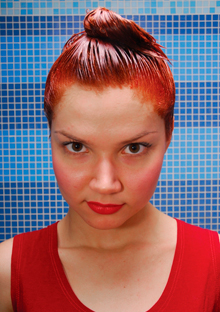
Photo: © 2009 Jupiterimages Corporation
We asked readers to share their home-haircolor mishaps and were flooded with stories of dye jobs gone very wrong. Here, the three most common problems—and how to fix them.
Q: When I decided to become a redhead, I picked a color that looked fabulous on the box and followed the directions. But I ended up bright orange. Help! — Kim, Madison, Connecticut
A: We got more stories from readers suffering from Carrot Top hair than anything else. Fortunately,the problem isn't too hard to fix. Apply demipermanent color (which lasts longer than semi- but isn't as harsh as permanent) in a medium or dark golden blonde to wet hair (when hair is wet, the dye goes on more sheerly). This should soften the orange tones without completely covering up the red, says Jason Backe, master colorist at the Ted Gibson Salon in New York City. Next time: If you're a blonde, choose a red that looks two levels darker than the one you want to achieve; if you have dark hair, choose a red one shade lighter, advises Jennifer J, a celebrity colorist and co-owner of Juan Juan Salons in Beverly Hills.
Next: How to get back to your original color
Q: My daughter started with a few highlights, but one mess after another led to a new color every few weeks. How can she get back to her original shade? — Kathy, Downers Grove, Illinois
Going back to natural can be one of the most difficult things to do with haircolor, says Jennifer J. First, your daughter should let her roots grow in so she can see her natural color. In the meantime, using a very sudsy shampoo (like Pantene Pro-V Purity Clarifying Shampoo, $5; drugstores) will fade the existing color, says Robert Ramos, a celebrity colorist in Los Angeles. When her roots are at least an inch long, she'll be ready for this three-step plan: 1. Apply a semipermanent dye one shade lighter than roots to dyed hair only, starting on just the left side and working from front to back. Leave the dye on for ten minutes (it's viscous enough that it won't bleed into the roots during this time), then rinse only that side (if you get the rest of the hair wet, just towel-dry); repeat on the right. Applying the dye in sections will give you more control over the color and avoid a multitonal look. 2. Shampoo, condition, and blow-dry to check the color. Repeat the process if it's not quite right. 3. Once you like the color, add shampoo to the leftover dye and work it through the hair, including roots, then rinse. This blends the roots with the ends, letting the natural shade grow in seamlessly.Next: How to fix streaky highlights
Q: I recently used a highlighting kit that came with a cap for separating out the hair to be colored. Now I have vertical orange stripes all over my head. Where did I go wrong? — Jane, Waxhaw, North Carolina
You probably pulled too much hair through the cap or didn't secure it tight enough to stop the dye from seeping through the holes. The hair you pull through shouldn't be thicker than a strand of spaghetti, and you should avoid getting any dye on the cap. To fix your problem, color all your hair with a semi- or demipermanent dye close to your original color; look for the words natural, ash, or neutral on the box. The color will cover the orange streaks but still leave them lighter than the rest of your hair. The result: Subtler highlights than you originally wanted—but no more tiger stripes. Dye your hair at home: 3 DIY hair makeovers you won't believe




